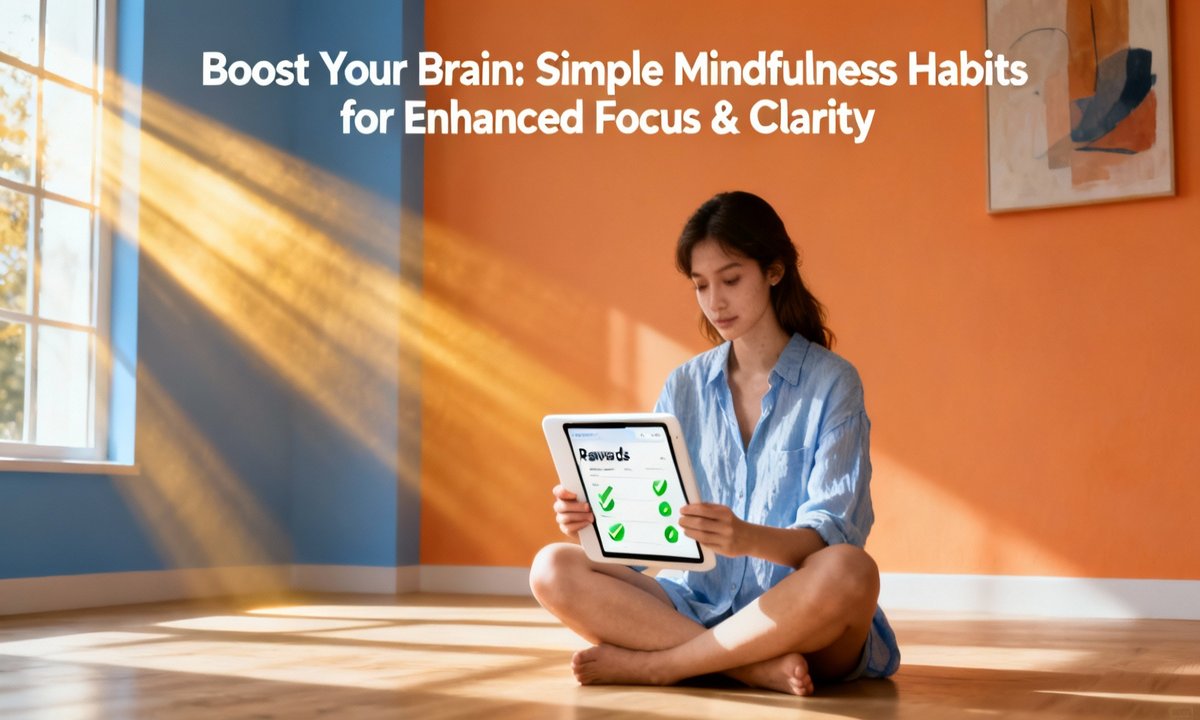Staying sharp and clear-headed can feel tough in a world overflowing with distractions. Yet, simple mindfulness habits are making a powerful difference for millions of Americans. With science on our side, now is the perfect time to boost your brain, sharpen your focus, and reclaim mental clarity—one mindful breath at a time.
Boost Your Brain: Simple Mindfulness Habits for Enhanced Focus & Clarity
The Growing Need for Focus and Clarity
The practice of mindfulness is rapidly growing across America. Data shows that meditation practice among adults more than doubled in the past two decades, climbing from 7.5% to 17.3% (https://www.nccih.nih.gov/health/meditation-and-mindfulness-effectiveness-and-safety).
Experts anticipate this trend will continue. By 2025, it is predicted that nearly 61 million adults—approximately one in five—will be actively practicing mindfulness (https://www.nature.com/articles/s41598-024-64562-y).
Why the surge? The benefits are clear. Mindfulness involves focusing your attention on the present moment without judgment. This practice consistently helps people quiet mental chatter and improve mental clarity (https://www.therapyroute.com/article/mindfulness-and-meditation-2025-statistics-by-therapyroute).
Daily overwhelm and work-related stress are common triggers for distraction. Studies reveal that 92% of people take up meditation primarily for stress relief. This pursuit of calm leads to profound workplace benefits.
Remarkably, organizations report that 86% of employees see better focus and 82% experience less stress after engaging in mindfulness routines (https://missiongraduatenm.org/meditation-statistics/).
This growing demand is fueling a booming mindfulness technology market. Last year, meditation apps generated $1.4 billion in revenue, with projections soaring to $7.25 billion globally by 2033. Tools like Headspace and Calm help people fit mindful moments into even the busiest routines.
Seven Simple Mindfulness Habits to Start Today
Ready to give your brain a real boost? Integrate these seven science-backed habits into your routine. No special equipment or experience is required to start your journey toward clarity.
1. Mindful Breathing
Spend 2–5 minutes tuning into your breath. Notice each inhale and exhale without changing them. This simple habit, when practiced several times a day, can help calm the nervous system and refresh your mind instantly.
2. Body Scan
Mentally scan your body from head to toe, noticing sensations without judgment. This guided awareness is excellent for releasing built-up stress, helping to reduce muscle tension and sharpen focus.
Combining this technique with brief yoga stretches can further support mind-body clarity. For more on healthy routines, explore tips for quick, healthy weeknight dinners (https://arowanakorea.com/quick-healthy-weeknight-dinners-busy-families).
3. Present-Moment Check-In
Every few hours, pause and check in on your current thoughts and feelings. Simply notice your environment, thoughts, and emotions—there is no need to fix anything. Cultivating this habit trains your brain to resist auto-pilot and distraction throughout the day.
4. Guided Meditation
Leverage meditation apps or online recordings for short, structured exercises. Five to ten minutes of guided practice can establish mental balance and build consistency, proving especially valuable for busy professionals.
5. Gratitude Journaling
Write down one to three things you are grateful for, either morning or night. The simple act of noting positive moments each day is shown to boost emotional resilience and mental clarity.
6. Movement Mindfulness
Bring a mindful presence to everyday movement, such as walking, stretching, or gentle yoga. Focus intently on bodily sensations and the rhythm of each step.
Movement can be both relaxing and grounding, while also supporting overall cognitive function. For nutrition tips to further support brain health, explore flavorful vegan recipes (https://arowanakorea.com/easy-vegan-weeknight-recipes).
7. Digital Mindful Breaks
Schedule mini-breaks from screens throughout your day. Stand up, look out a window, or simply close your eyes for a full minute. These brief digital breathers are essential for resetting your attention span before the next task.
Cognitive Benefits of Consistent Practice
The science is compelling: regular mindfulness habits measurably sharpen focus and mental clarity. Multiple studies report up to a 60% reduction in anxiety within six to nine months of consistent practice (https://missiongraduatenm.org/meditation-statistics/).
Participants also experience improved emotional stability, impulse control, and productivity. These benefits naturally carry over into both personal and professional life, creating a strong foundation for sustained well-being.
It is important to recognize that mindfulness is not just about reducing stress. It actively remodels brain pathways. Research demonstrates strengthened connections in regions tied to attention, memory, and decision-making (https://www.nccih.nih.gov/health/meditation-and-mindfulness-effectiveness-and-safety).
For professionals facing daily decision fatigue, these focus enhancement techniques become an essential and powerful toolkit. Creating a supportive environment also matters greatly.
Enhancing your living space with clean air and calming greenery can further prime your brain for mindfulness. Learn more about boosting your home’s air quality (https://arowanakorea.com/improve-air-quality-indoor-plants) to support your practice.
Practical Strategies for Daily Integration
Building consistent mental clarity does not require overhauling your entire schedule. Effective strategies exist for making mindfulness stick naturally within your daily routine.
Making Mindfulness Stick
Set a Regular Schedule
Anchor your practice to existing daily routines, such as right after waking up, during lunch breaks, or just before bed. Consistency is key to long-term success.
Start Short and Simple
Begin with two-minute sessions and only add time as it feels comfortable and natural. Small, achievable increments prevent burnout.
Leverage Technology
Apps and digital reminders can keep mindfulness top-of-mind. Consider joining interactive challenges or connect with virtual community groups for support.
Join a Group
Local or virtual mindfulness circles provide encouragement and accountability. This community aspect makes it easier to stay motivated and on track with your goals.
Track Your Progress
Jot down what you notice after each session. Do you feel more present or calmer? Sentiment tracking can offer powerful feedback and fuel continued motivation.
Remember, creating a mindful lifestyle extends beyond just meditation. Stressors like financial worries can cloud your mental sky. Explore helpful practices for smart spending habits (https://arowanakorea.com/frugal-living-financial-freedom) to ease anxiety and create space for focus.
Who is Practicing Mindfulness? Demographic Trends
Mindfulness is accessible for everyone, regardless of age or background. Regular practice yields measurable improvements for people in their twenties through their retirement years.
Middle-aged adults (45–64) currently represent the largest group of practitioners (15.9%). However, growing numbers of young adults and seniors are also beginning to reap significant rewards.
Demographic data also shows a notable trend: women meditate nearly twice as often as men (https://missiongraduatenm.org/meditation-statistics/).
Motivations for practice vary by age. Younger people often seek performance enhancement and stress relief. Older adults typically prioritize overall wellness and improving sleep quality (https://www.nccih.nih.gov/health/meditation-and-mindfulness-effectiveness-and-safety).
Frequently Asked Questions (FAQ)
How long do mindfulness habits take to show results?
Most individuals experience initial benefits, such as reduced stress and improved focus, within a few weeks of consistent practice. However, lasting change builds over several months and is strengthened by continued effort (https://missiongraduatenm.org/meditation-statistics/).
Are these habits suitable for beginners?
Absolutely. All seven featured habits are easily adapted for newcomers and require no prior experience or complex instruction.
Can mindfulness help with work-related stress?
Yes. Nearly nine out of ten workers report experiencing better focus and significantly reduced stress after adopting workplace mindfulness routines (https://missiongraduatenm.org/meditation-statistics/).
Is mindfulness safe for everyone?
The National Institutes of Health reports that meditation is safe for most people. If you have any concerns about underlying mental health conditions, always consult a healthcare professional first (https://www.nccih.nih.gov/health/meditation-and-mindfulness-effectiveness-and-safety).
Insights from the Mindfulness Community
Hearing from others can inspire your own journey toward clarity and calm.
Real-Life Success Stories
Martha, a 48-year-old project manager, shared her experience with mindful breathing on her morning commute. She noticed, “I walk into work with a clearer head and less tension. It sets a peaceful tone for my entire day.”
David, a graphic designer, found great value in a digital mindfulness group, noting: “Checking in with others made me more accountable. I’m amazed at how my concentration has improved during creative projects.”
Jenna, who balances remote work and raising kids, discovered the power of present-moment check-ins. “Even a single minute between meetings helps me reset. My kids have started joining me too—it’s become a family ritual!”
Resources for Deeper Understanding
Deepen your understanding and keep leveling up your mindfulness habits by exploring trusted resources.
– [Mindful.org](https://www.mindful.org) – A comprehensive resource for mindfulness techniques and daily practices.
– [NIH Mindfulness Overview](https://www.nccih.nih.gov/health/meditation-and-mindfulness-effectiveness-and-safety) – Science-based articles on safety and benefits.
For a holistic approach to well-being, remember that physical health supports mental focus. Explore nourishing your mind and body with vegan recipes (https://arowanakorea.com/easy-vegan-weeknight-recipes).
You can also optimize your environment for calm. Read about how to boost your home’s air quality (https://arowanakorea.com/improve-air-quality-indoor-plants) or enhance your daily routine with quick, healthy dinners (https://arowanakorea.com/quick-healthy-weeknight-dinners-busy-families).
Take the Next Step Toward Mental Clarity
– Join our newsletter for more brain-boosting tips!
– Download a free mindfulness habits checklist to keep your progress on track.
– Share your focus improvement story with our growing community!
We encourage you to share how you are integrating mindfulness into your routine. Join the conversation and take our quick poll below—your journey could inspire others seeking clarity and calm.
Editorial note: Mindfulness is not a cure-all, but it empowers meaningful, sustained improvements in brain health, emotional resilience, and quality of life. Your mindful moments matter.
Ready for more? Dive into tips on smart spending habits for financial freedom (https://arowanakorea.com/frugal-living-financial-freedom) and improving your home’s air quality (https://arowanakorea.com/improve-air-quality-indoor-plants). After all, a peaceful mind often starts with a peaceful space.



